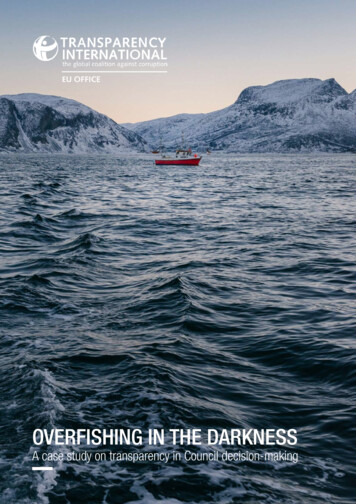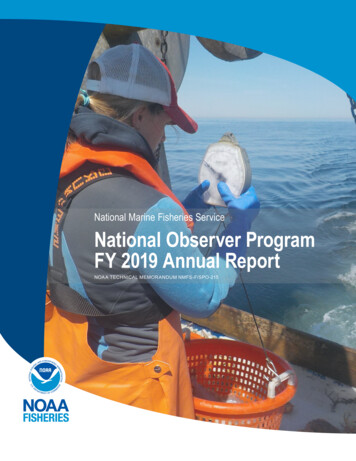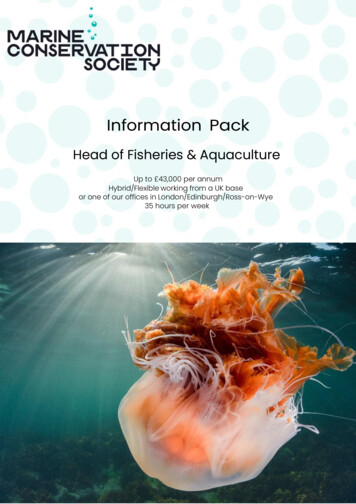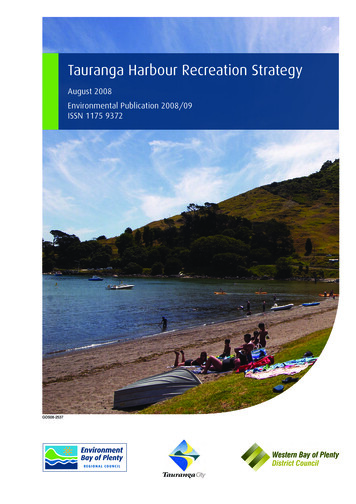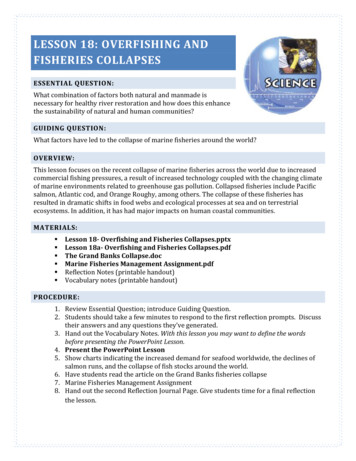
Transcription
LESSON 18: OVERFISHING ANDFISHERIES COLLAPSESESSENTIAL QUESTION:What combination of factors both natural and manmade isnecessary for healthy river restoration and how does this enhancethe sustainability of natural and human communities?GUIDING QUESTION:What factors have led to the collapse of marine fisheries around the world?OVERVIEW:This lesson focuses on the recent collapse of marine fisheries across the world due to increasedcommercial fishing pressures, a result of increased technology coupled with the changing climateof marine environments related to greenhouse gas pollution. Collapsed fisheries include Pacificsalmon, Atlantic cod, and Orange Roughy, among others. The collapse of these fisheries hasresulted in dramatic shifts in food webs and ecological processes at sea and on terrestrialecosystems. In addition, it has had major impacts on human coastal communities.MATERIALS: Lesson 18- Overfishing and Fisheries Collapses.pptxLesson 18a- Overfishing and Fisheries Collapses.pdfThe Grand Banks Collapse.docMarine Fisheries Management Assignment.pdfReflection Notes (printable handout)Vocabulary notes (printable handout)PROCEDURE:1. Review Essential Question; introduce Guiding Question.2. Students should take a few minutes to respond to the first reflection prompts. Discusstheir answers and any questions they’ve generated.3. Hand out the Vocabulary Notes. With this lesson you may want to define the wordsbefore presenting the PowerPoint Lesson.4. Present the PowerPoint Lesson5. Show charts indicating the increased demand for seafood worldwide, the declines ofsalmon runs, and the collapse of fish stocks around the world.6. Have students read the article on the Grand Banks fisheries collapse7. Marine Fisheries Management Assignment8. Hand out the second Reflection Journal Page. Give students time for a final reflectionthe lesson.
ASSESSMENTS:Marine Fisheries Management Assignment.pdfWASHINGTON STATE STANDARDS:SCIENCE1. EALR 1: Systems2. If the input of matter or energy is the same as the output, then the amount of matter orenergy in the system won’t change; but if the input is more or less than the output, thenthe amount of matter or energy in the system will change.a. Measure the flow of matter into and out of an open system and predict how thesystem is likely to change (e.g., a bottle of water with a hole in the bottom, anecosystem, an electric circuit).3. EALR 4: Life Sciencea. LS2D Ecosystems are continuously changing. Causes of these changes includenonliving factors such as the amount of light, range of temperatures, andavailability of water, as well as living factors such as the disappearance of differentspecies through disease, predation, habitat destruction and overuse of resourcesor the introduction of new species.i. Predict what may happen to an ecosystem if nonliving factors change or ifone or more populations are removed from or added to the ecosystem.b. LS1C Multicellular organisms have specialized cells that perform differentfunctions. These cells join together to form tissues that give organs their structureand enable the organs to perform specialized functions within organ systems.i. Explain the relationship between tissues that make up individual organsand the functions the organ performs.ii. Describe the components and functions of the digestive, circulatory, andrespiratory systems in humans and how these systems interact.SOCIAL STUDIES1. EALR 5: The student understands and applies reasoning skills to conduct research,deliberate, form, and evaluate positions through the processes of reading, writing, andcommunicating.a. Component 5.2: Uses inquiry-based research.WRITING1. EALR 2: The student writes in a variety of forms for different audiences and purposes.a. Component 2.1: Adapts writing for a variety of audiences.b. Component 2.2 Writes for different purposes.
ADDITIONAL RESOURCES AND .ted.com/talks/sylvia earle s ted prize wish to protect our oceans.htmlhttp://www.ted.com/index.php/talks/capt charles moore on the seas of plastic.htmlThis is just amazinghttp://www.ted.com/index.php/talks/david gallo shows underwater astonishments.html
VOCABULARY TERMS:Fisheries- A fishery is an eco-region and an associated fish population used forcommercial fishing purposes. Examples would be the salmon fishery of Alaska or the codfishery of Newfoundland.Collapse- When a harvestable species (usually fish) see their population or harvest ratedrop to less than 10% of the original figure. It means that harvesting is no longersustainable and the fish is in danger of economic extinction.Fishfinder sonar- Fishfinder sonar uses sound waves to detect the location of fish, sothat they can be harvested. Sound waves are sent from the ship and reflect off the bodiesof fish. The time it takes for the sound waves to return to the ship and the angle of returnindicate the distance and location of the fish.Fish Farm- A facility used to raise commercially viable fish species from egg to adulthoodto sell for the market.Aquaculture- Raising aquatic organisms in contained units for the purpose of producingmarketable products. This can include algae, shrimp, oysters, fish, and others.Hatchery- A facility used to rear juvenile fish for the purpose of stocking rivers or lakes,producing fish for commercial fishing activities, or restoring endangered fish populations
Elwha River RestorationOverfishing and Fisheries CollapsesReflection Journal 1How much fish do you and your family eat? What is your favorite kind of fish to eat and why is ityour favorite? How do you like it prepared?What questions do you have about fish, fishing and fisheries?
Elwha River RestorationOverfishing and Fisheries CollapsesVocabulary NotesFisheries:Collapse:Fishfinder sonar:Fish Farm:Aquaculture:Hatchery:
Elwha River RestorationOverfishing and Fisheries CollapsesReflection Journal 2What do you think we can do to bring fish back to oceans and rivers? Defend your thinking.What questions or comments do you have about fish, and/or overfishing?
The Grand Banks: Where Have All the Cod Gone? New Scientist 16 Sept 96 p24Thirty years ago, children in Newfoundland could catch fish by dipping a basket into the ocean.Now Canadian research vessels sweep the seas in vain, finding not a single school of cod in whatwas once the world's richest fishery. The destruction of the Grand Banks cod is one of the biggestfisheries disasters of all time. And science helped make it happen. The Canadian governmentbanned fishing on the Banks in 1992, when scientists discovered there were nearly no adult codleft. That ban is likely to remain in place for at least a decade. Canada has blamed Spaniards, sealsand the weather. But the real damage was done by years of "safe" catches that scientists nowrealize were just the oppositeHow the Banks collapsedThe disaster of the Grand Banks is a compendium of the mistakes made in fisheries all over theworld. When scientists began to manage the Banks in the 1950s they promised to assign "safe"quotas to Canadian and foreign fleets. They failed. The cod catch fell from 810,000 tons in 1968to 150,000 tons by 1977. Canada blamed foreign disregard for quota extended its jurisdiction200 nautical miles offshore, and evicted the foreigners.Scientists set catch limits calculated to allow stocks to recover, predicting catches of 400,000tons by 1990. In anticipation the government helped people in Canada's Atlantic Provinces tobuy new boats and fish plants. The bonanza never happened. Every year scientists of theCanadian Department of Fisheries and Oceans (DFO) estimated the size of the fish stocks, and setthe "total allowable catch", or TAC, at 16 per cent of the fish, which theory said should allowstocks to increase. But stocks never rose enough to allow TACs greater than 260 000 tons, fallingwell short of predictions. That wasn't necessarily a disaster, the scientists reasoned. The size offish populations was held to be dominated by the survival rate of young fish, which varies widelyand unpredictably. The slow recovery might simply mean a few bad years. But there were otherworrying signs.The fish were smaller, a sign that each stood less and less chance of surviving the year. And thefleet was fishing a smaller and smaller area of ocean. But the scientists had no means of reactingto any of these portents. They were employed simply to go out every year, collect particular data,estimate stocks and set the year's TACS. Every autumn the DFO research vessel would sail arandom course across the Banks, trawling and counting how many fish it caught at different ages,and how long they took to catch, to get data for standard fisheries models. Other data came fromthe number of fish the commercial fleet caught per hour of fishing. If they caught more fish perhour this year than last, the stock was held to be larger; if fewer, the stock was smaller.Then in 1989, there was a discrepancy. The commercial data suggested there were twice asmany fish as the research data did. The fishermen were catching more fish per hour than thescientists because they were going to warmer patches where they knew cod were congregating.The research vessel, on its random course, was encountering empty ocean. That was the accuratepicture. But the scientists were reluctant to favor their data over the fleet's. After all, they madeonly one cruise; the fleet made hundreds. And they didn't want to believe that the wholetheoretical basis for their work was wrong. The error worsened: in 1992, the DFO reported, thearea fished had "decreased substantially" since 1987. Tony Pitcher, of the University of BritishColumbia, says schools of fish such as cod or haddock huddle together in a small area when they
are depleted. There, you get a false impression that there are lots of fish, while the surroundingocean is empty. By contrast, he says, hake eat each other, and thus stay well apart over theirrange. For hake, catching effort gives a more accurate picture.The fishing industry stuck with its false impression. The processing company National SeaProducts said in 1990 that scientists only thought fish stocks were low because they surveyedlarge areas of ocean randomly, and didn't "go where the fish are "where they would find that"fishing has never been better". Fishing had never been better, because during the 1980s, aidedby subsidies, fishermen bought more powerful boats and new, accurate fish-finding sonar. Thiswas intended precisely to increase the catch per unit effort. Yet scientists took no account ofbetter technology in calculating stock size. So in 1989, the DFO was in a quandary. They lackedconfidence in their own data, were reluctant to abandon received wisdom and the region's mainemployer insisted that fishing was fine. The DFO compromised and decided the stock wasmidway between the research and commercial data. This was still smaller than they had thought.Retrospective calculation of the fishing that would have produced such a stock showed boats hadbeen taking not 16 per cent of the fish each year as planned, but at least 60 per cent. Thescientists advised a TAC of 125 000 tons, well below the 266 000 of 1988. Then politics took ahand. The fisheries minister refused to anger fishermen by slashing catches that much. LesleyHarris, a former president of Memorial University in Newfoundland who chaired a governmentinquiry into the fishery in 1990, says the DFO should have insisted. "But scientists beingscientists, they weren't prepared to make absolute statements about anything," he says."Politicians used the uncertainty to set catches as high as possible." This meant 235 000 tons.In January 1992, the DFO recommended a TAC of 185 000 tons. Then it did another researchcruise-and cut that to 120 000. Then in June, it recommended banning fishing altogether.Suddenly, the scientists realized there were no cod old enough to spawn left. By now thefishermen were worried too, and agreed to a fishing moratorium on the Bank and adjacentfisheries. In 1993, it was extended indefinitely.Lost JobsThe aftershock of that realization is still being felt, and not only by the thousands of fishermenand fish plant workers who lost their jobs. The death of the Grand Banks has done for the fishingindustry what the Antarctic ozone hole did for the chemicals industry: scared everyone out oftheir complacency. How could an advanced nation with an army of scientists allow one of therichest fisheries in the world to go to be destroyed? And if Canada could do that, what hope isthere for the coastal fisheries of Europe, hostage to politics as well as science?The Grand Banks fell prey to the usual list of suspects: a government that set fishing limits higherthan scientists advised; fishermen who cheated on catch quotas; and the lack of restraint thatplagues all "open access" fisheries ("if we don't catch them, other boats will"). But press theexperts harder and an additional culprit emerges-the scientific models used for estimatingsustainable catches. According to those models, the Grand Banks should still be full of fish. Mostexperts admit the models are inaccurate. Yet only a few seem to realize the seriousness of theerror, and even fewer are trying to come up with something better. In the meantime, the modelswhich failed the Grand Banks are being used to govern fisheries around the world.
Daniel Pauly of the International Centre for Living Aquatic Resources Management in thePhilippines blames a culture of defensiveness. "It is a commonly held fallacy among fisheries’biologists that only the fishers, or the politicians, are a fault when overfishing occurs," he writes.But "models routinely used by biologists . induce overfishing". The good news is that at leastsome researchers are starting to make changes. They now realize that Canada's biologists reliedtoo much on data from commercial catches to estimate the sizes of fish stocks (see "How theBanks collapsed"). Nor was this the only problem.Canada's biologists also based their assessments of the number of fish it would be safe to catchon two flawed assumptions about fish biology. The central problem is that fish live in the sea.You cannot count them or see how many young fish are coming along for future catches. Thisproblem is compounded by the chaotic way fish reproduce. "Recruitment"-jargon for the numberof fish that survive to a catchable state in any one year-varies widely and unpredictably fromyear to year, and there is no way of measuring it directly.Time travelSo since the 1950s, biologists have instead caught samples of fish, determined their ages andcalculated back in time the populations that would be necessary to produce the observed ageprofile. Such a model tells you in theory what the recruitment has been, how the size of the stockhas changed, and therefore how much fishing you can allow.But to do this, you need to make some big assumptions. And it's these that are the problem,according to Sidney Holt who studies whaling for the International Fund for Animal Welfare. As aresearcher at the British government's fisheries research lab at Lowestoft in the 1950s, Holthelped to develop the Beverton-Holt model, widely used in fisheries to estimate changes in stocksizes based on age profiles. Now he is critical of the simplistic way fisheries’ managers haveapplied the model. And in a message to a conference in Vancouver this year, Holt's formercolleague, the late Ray Beverton noted that "there is a strong inverse association between thegrowth of fisheries science . and the effectiveness with which it is applied". Part of the problemis that the age profiles of fish populations are not governed by recruitment alone.They also depend on the death rates of fish, and "the data give you no way to untangle the two",says Holt. So scientists calculate recruitment from age data by assuming that natural mortality isconstant and independent of age-and that they know, accurately, what mortality from fishing hasbeen. "But if those assumptions are wrong, your estimate can be wildly off," says Holt. Pauly saysthis sort of error tends to produce estimates of safe catches that are too big. And if you thinkmanagers have applied the model. And in a message to a conference in Vancouver this year,Holt's former colleague, the late Ray Beverton noted that "there is a strong inverse associationbetween the growth of fisheries science . and the effectiveness with which it is applied".Part of the problem is that the age profiles of fish populations are not governed by recruitmentalone. They also depend on the death rates of fish, and "the data give you no way to untangle thetwo", says Holt. So scientists calculate recruitment from age data by assuming that naturalmortality is constant and independent of age-and that they know, accurately, what mortalityfrom fishing has been. "But if those assumptions are wrong, your estimate can be wildly off," saysHolt. Pauly says this sort of error tends to produce estimates of safe catches that are too big. And
if you think you have more fish than are actually out there, you will allow too much fishing. Yourstock size will then fall. It gets worse.Because of another wrong assumption, biologists have been slow to heed this warning signal.They have assumed that no matter how stocks dwindle, there will always be enough adult fish toproduce the usual number of young; in other words, that recruitment is unaffected by stock size.This assumption may seem counterintuitive to people accustomed to cats or dogs, or humans, forwhom the number of babies depends quite closely on the number of parents. But for naturalpopulations of fish, they do not. "A cod produces eight million eggs," explains Lesley Harris, aformer president of Memorial University in Newfoundland, who chaired an inquiry into thefishery in 1990. "Only a tiny fraction survive.A tiny difference in that survival rate makes huge differences to the resulting number of fish, farmore difference than comparatively small variations in the number of parents." Most fisheriesscientists have assumed that this condition always holds. But Holt says that "even in the 1950s,we knew it didn't and that this could cause problems". As stocks dwindle there comes a pointwhere smaller numbers of adult fish do cause recruitment to fall, perhaps because the totalnumber of eggs laid ceases to be so massively in excess of the numbers that survive, perhapsbecause the presence of fewer adults exposes the young to more predation.But whatever the reason, recruitment falls when fishing pressure is intense (see Figures). "If theassumption that recruitment is independent of stock size is applied to depleted stocks-as hascommonly been done-then sustainable catches will be grossly overestimated," says Holt. This isbecause of a knock-on effect in successive years: fishing reduces the spawning stock, whichreduces recruitment, which reduces the spawning stock, and so on. If you assume thatrecruitment will fall within its natural range whatever happens, and replenish the stocksaccordingly, you will continue to permit these catches, thinking that you are only having a "fewbad recruitment years". Instead, the stock can disappear. And this is precisely what happened onthe Grand Banks. But fisheries’ managers have yet to change their ways.If recruitment declines over a number of years, they still attribute it to unpredictable but naturalvariations, rather than suspecting excessive catches. "Until about two years ago, we didn't realizethe importance of the spawning stock," says Henrik Sparholt of the International Council for theExploration of the Seas, an intergovernmental body, based in Copenhagen, which recommendscatch limits to many governments. Sparholt blames governments, which regularly set allowablecatches higher than the ICES recommends, for the fall in European stocks, not faulty science. Yethe admits that many stocks in Europe may be at or below the threshold where recruitmentdepends on stock size. This means that overfishing could continue even if scientific advice isheeded because the advice may be wrong. And once depleted, a fishery may not always recover.Other species may fill the ecological niche of the former fish, and keep the recovering stock fromresuming its previous place in the ecosystem.A commercial fish called the slipmouth was replaced by squid in the Gulf of Thailand, says Pauly;back on the Grand Banks, yellowtail flounder "may not come back", says Harris, while thehaddock population wiped out in the 1950s "has never recovered". The belief that everythingdepends on yearly recruitment means that virtually all fisheries are managed on a yearly basis,with no long-term planning. Why plan if your resource depends on unpredictable yearlyfluctuations? And why worry unduly about overfishing if even a small spawning stock can in
theory bring the population back? "History shows a long term drop in recruitment afteroverfishing in every single case," says Harris. "It's been true of herring, redfish, haddock, cod,flounder, American plaice, and Greenland halibut."It is time to stop ignoring the evidence, he says. Yet few scientific dogmas have been as difficultto dislodge as the notion that the number of fish produced has nothing to do with the numberavailable to breed. "It has been extraordinarily difficult to dissuade fisheries biologists fromapplying simple formulas like recipes and getting half-baked answers," says Holt. In theirdefense, biologists may not realize what a big difference such critical assumptions make to thesuccess of their models, because they have never tested them. You can't test ecological models byrunning varying versions of the real world.It was the experimental use of modeling for evaluating whale management proposals thatconvinced Holt. He is one of a handful of scientists advocating simulation as a tool to findmanagement procedures that work. The key, he says is to avoid basing your catch estimate onpopulation models that rely on making assumptions about immeasurable variables. Nor shouldyou assume that you can accurately measure the stock "You might conclude that it's safe to catch20 whales this year, and do the same next year and the next," says Holt "But given the difficultyof counting whales, if that catch is too high, then by the time its cumulative effects show in stockassessments, the stock might have already been badly damaged." The same applies to fish. Howdo you avoid either assumption? You take your computer fishing. "You start with a hypotheticalpopulation of fish, about which you know only its size an estimate of the statistical error of thatvalue, and its catch history," says Holt. This is information scientists can actually collect. "Then,you invent an algorithm and management procedure, with which given what you know about thepopulation, you calculate a safe catch limit.There is nothing special about such algorithms, says Holt, although they can be very complex,changing the permitted catch according to a host of measurable factors that influence fisheries,depending on the type of information available. It may use information about how much fishingeffort is required to catch fish, for example, or it may not. The point is that whatever yourmethod for calculating catches, you test it. You run a simulation, where you use the same methodyear after year, and see whether it crashes your stock. Then you repeat the simulation, imposingdifferent conditions each time. What if the stock is really half what you think? What if thealgorithm says we should cut fishing if the spawning stock falls beneath a certain level, but it
really should be another level? "And you run it again," says Holt, "and see if your managementprocedure is conservative enough to keep the stock from crashing even if you're wrong."This allows the setting of long-term goals, such as maximizing yield while keeping the risk ofdepletion to agreed levels. "We can achieve sustainability without significant risk of inadvertentdepletion, and reasonably high-but certainly not theoretically maximal catches in the long run,"says Holt. That would suit the fishing industry, says Peter Spohr, head buyer for Nordsee,Europe's largest fish processor. "We .prefer a predictable catch to the feast or famine we havenow."Sorry plightEfforts to apply computer simulation to European fisheries are being made at the Britishgovernment's fisheries labs in Lowestoft. Such research could help to form long-term fisheriesgoals, which the European Commission was given the power to propose in 1992. So far, theEuropean Union's fisheries ministers have not agreed even to modest proposals. Scientistsremain among the obstacles. There is immense resistance to admitting that the methods areflawed and few scientists want to discuss work on new approaches, such as computer simulation.One who did not wish to be named said that "it would imply that what we are doing now iswrong". Some believe the sorry plight of the Grand Banks has already proved that. "Thepopulation crashed faster than I thought possible in 1990, and I was a pessimist," says Harris."The northern Banks are a desert. Cruises in the past two years have found no cod at all."Trashing the Planet NS 3 Oct 98 12NORWEGIANS, who pride themselves on their green credentials,are the most environmentally destructive people on Earth, saysa report published this week by the World Wide Fund for Nature(WWF) in Geneva. The report estimates the pressure thatnations put on global ecosystems by their exploitation of fourkey natural resources grain, marine fish, wood and freshwater aswell as their contribution to global warming through carbondioxide emissions and their consumption of land, measured bycement production. Per head of population, a Norwegian putsfour times as much pressure on the environment as the averageglobal citizen-and 50 per cent more than either Americans orAustralians.
The country's worst offence, says Jonathan Loh, the compiler of the index, is its consumption ofmarine fish. Per person, Norway catches 250 kilograms of marine fish each year, more than 10times the world average. Much of it is not eaten directly, but fed to salmon on fish farms aroundthe coast. The citizens of Taiwan, Chile, Singapore and Denmark, all major fish consumers, arethe worst offenders after Norway. The US, Australia, Kuwait and Canada also appear in the top12. Britain lies in 41st place, while Bangladeshis have the least impact on the environment. "Itwould of course be possible to obtain different results by applying different weightings todifferent components in the index," says Loh. Alex MacGillivray of the London-based NewEconomics Foundation, which gathered data for the report, points out that environmentalindicators can never be perfect (see Editorial, 4 April, p 3). "There is always a subjective elementin what you decide to include and how you weigh the different elements," he says. "But they doserve a role in highlighting environmental villains and ecological pressures, some of themunexpected.The Norwegians are one example." The Norwegian government this week defended itsenvironmental record. Paul Hofseth, special adviser to the environment ministry in Oslo, says:"We only use half of the timber that grows in our country each year. And we believe we makesustainable use of our marine fish. I can't see how that damages the global environment." Othervillains emerge within the other five indicators. Americans use twice as much grain as theaverage citizen, 692 kilograms per head per year. Swedes use the most wood, 2.3 cubic meters almost four times the global average. And the four biggest consumers of freshwater are thecentral Asian republics that drain the Aral Sea to irrigate their cotton fields. The WWF reportalso looks at the world's key ecosystems: forests, freshwater and the marine environment. All arein decline, but freshwater ecosystems came out worst. Numbers of 200 vertebrate species usedas indicators of freshwater health fell by half. Altogether, the report concludes that the health ofthe world's ecosystems has declined by 30 per cent in 25 years. Fred Pearce
Marine Fisheries Management, History, Techniques, and Impact UnitUse the internet and maps to answer the following questions1) Name the top 5 consumers of fish per capita in the world.123452) The locations listed below are the greatest fisheries in the world for total fish production.For each location, examine a map and describe what geographical and ecological featuresthey share in common.North SeaGrand Banks (near Newfoundland)Gulf of AlaskaNew Zealand3) The average American eats pounds of fish per year (per capita).4) One in ten fish caught is eaten in .5) Marine sources represent % of the world’s protein consumption.6) Look at the graph. Explain what thisdata represents.Sea of Okhotsk
7) Examine the map below. Greenareas represent areas of highproductivity. Name three areas8) where there would be large fishstocks without governmentclaims?9) Examine the table below.SpeciesPacific herringAtlantic herringAtlantic codSo. AfricanSardinesHaddockPeruvian anchovyPolar codCape hakeSilver hakeYellow croakerAtlantic redfishChub mackerelSo. AmericanSardinesAlaska pollockNorth Pacific hakeTOTALS 1986 6.80.50-26%1987 0.300.06-80%--51.48 21.77 -58%a) What is the most caught fishin the world?b) Which fish have seen thegreatest total decline in catch sincetheir peak?c) Which fish have seen thegreat percentage in decline sincetheir peak?d) Which fish has seen theleast decline?10)Explain what aquaculture isand what effects it may have onover
With this lesson you may want to define the words before presenting the PowerPoint Lesson. 4. Present the PowerPoint Lesson 5. Show charts indicating the increased demand for seafood worldwide, the declines of salmon runs, and the collapse of fish stocks around the world. 6. Have students read the article on the Grand Banks fisheries collapse 7.


